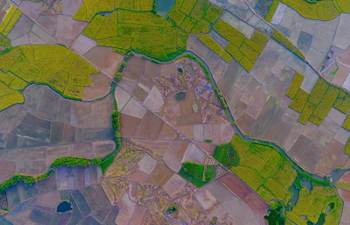SAN FRANCISCO, Aug. 13 (Xinhua) -- Researchers at Stanford University are working on an artificial eclipsing system to help them image extrasolar planets, which could be Earth-like and carrying extraterrestrial life.
Similar to how a person can not look at anything too close to the sun, current telescopes can't observe potential Earth-like planets because they are too close to the stars they orbit, which are about 10 billion times brighter than the planets that surround them, according to a news release from Stanford earlier this week.
As explained by Simone D'Amico, assistant professor of aeronautics and astronautics at Stanford and director of the Space Rendezvous Laboratory, a possible solution might be to create an artificial solar eclipse with two precisely positioned spacecraft.
One craft, known as a starshade, would position itself like the moon in a solar eclipse, blocking out the light of a distant star; and a second spacecraft with a telescope could view the nearby exoplanets from within the shadow cast by the starshade.
However, proposed observatories capable of imaging Earth-like planets require a starshade tens of meters in diameter separated from the telescope by a distance equal to multiple Earth diameters, and the formation would have to be deployed beyond Earth orbit.
Altogether, the mission would cost billions of U.S. dollars. Instead of sending a pricey, untested system into space, the Space Rendezvous Laboratory, in collaboration with exoplanet expert Bruce Macintosh, professor of physics at Stanford, has created a smaller version of this formation, likely to cost millions of dollars.
The primary objective of this mission, said the researchers, is to provide a low-cost flight demonstration of starshade technology to increase the confidence of the scientific community in the capabilities of a full-scale observatory.
Called mDOT, for miniaturized distributed occulter/telescope, the system includes two parts: a three-meter diameter starshade on a 100-kilogram microsatellite and a 10-centimeter diameter telescope on a 10-kilogram nanosatellite. The starshade and telescope will be deployed in high Earth orbit with a nominal separation of less than 1,000 kilometers.
The shadow produced by mDOT's starshade is tens of centimeters in diameter, which means the telescope's lateral position relative to the starshade has to be controlled to within about 15 centimeters.
Due to the challenging requirements, the only way to realize mDOT is through an autonomous spacecraft formation flying system that is not affected by the communication delays between the satellites and the mission operators on Earth.
In their design, the researchers have both spacecraft fly in a large orbit with the starshade eclipsing the target star at the point of the orbit that's farthest from Earth, namely the point at which the spacecraft are moving the slowest relative to each other. After about an hour of this tight positioning, they will allow the formation to break up until it is nearly time for the spacecraft to line up again for the next observation.
While tens of hours of observation time are needed to demonstrate that the starshade is working as intended, the miniaturized mDOT won't be able to resolve Earth-like planets because they are still too close to their parent stars. It could, however, give the scientific community a direct glimpse at another star system's equivalent of Jupiter or help characterize exozodiacal dust concentrations around nearby stars.
"With indirect measurements, you can detect objects near a star and figure out their orbit period and distance from the star," D'Amico was quoted as saying in the news release.
"This is all important information, but with direct observation you could characterize the chemical composition of the planet and potentially observe signs of biological activity - life," he said.

















